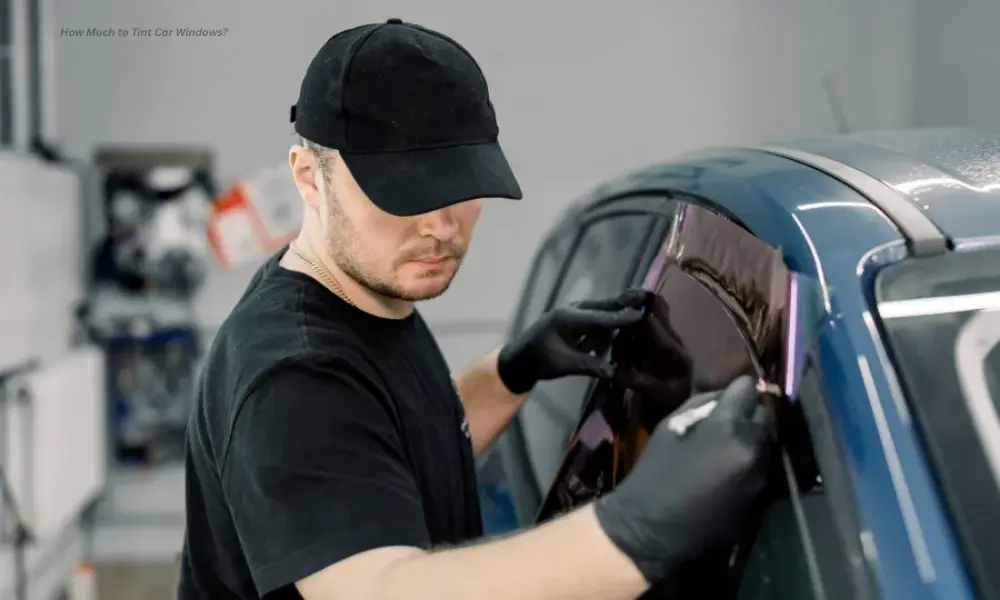How Much to Tint Car Windows? (Full Cost Breakdown in 2025)

Looking for a quick answer? Car window tinting typically costs between $100 and $400 depending on the type of vehicle, quality of tint, and where you get it done. Basic tinting for a sedan can be as low as $100, while high-end ceramic tinting for an SUV can push over $600.
Table of Contents
What is Window Tinting?
A Quick Overview
Window tinting is the process of applying a thin laminate film to a vehicle’s glass. It reduces glare, blocks UV rays, adds privacy, and makes your car look sleek.
Why Do People Tint Their Car Windows?
Some people want more privacy. Others want protection from sun damage or to keep the car cooler. And let’s be honest—tinted windows just look cool.
The Straightforward Answer: How Much to Tint Car Windows?
Average Cost Range
Here’s a quick breakdown of the:
- Sedan (5 windows): $150–$300
- SUV (7–9 windows): $200–$500
- Coupe (2 doors): $100–$250
- Luxury or exotic cars: $400–$800+
Basic Tint vs. Premium Tint
- Basic dyed film: $100–$200
- Carbon tint: $200–$400
- Ceramic tint (top-tier): $400–$800
Vehicle Type Matters
Larger vehicles like SUVs or vans usually cost more because they have more windows or larger glass surfaces.
Factors That Affect Tinting Costs
- Type of Film Used
The film type significantly impacts price:
- Dyed film: Cheapest, fades faster
- Metalized: Reflects heat, can interfere with GPS
- Carbon: Better heat blocking, no signal interference
- Ceramic: Best performance, most expensive
- Number of Windows
More windows = more film = higher cost. Tinting just the front windows can be as low as $50–$100.
- Quality of Installation
Professional installers charge more, but you get quality work with warranties. Cheap installs might peel or bubble.
- DIY vs. Professional Tinting
DIY kits range from $20–$80. But unless you’re skilled, you risk bubbles, misalignment, and wasting your money.
Types of Window Tint Films
- Dyed Window Tint
Inexpensive, provides a darker look but minimal heat rejection. Fades over time.
- Metalized Window Tint
Durable, reflects heat and UV rays, but may interfere with electronics.
- Ceramic Tint
Top-tier. Blocks UV, IR, and heat without affecting electronics. Long-lasting but pricey.
- Carbon Window Tint
Blocks more heat than dyed or metalized films, with a sleek matte finish. Doesn’t interfere with devices.
- Hybrid Tint
A blend of dyed and metalized films. Offers decent heat rejection and UV protection at a moderate cost.
Legal Considerations
Tinting Laws by State or Region
Every region has its own rules. For example, California allows 70% VLT on front windows, while Florida permits 28%. Check your local DMV site.
What Happens If You Break the Law?
Fines vary by location—could be $50 or over $200. You might even be forced to remove the tint entirely.
Is Car Window Tinting Worth It?
Pros of Tinting
- Privacy – Keeps prying eyes out
- UV Protection – Blocks up to 99% harmful rays
- Cooler Cabin – Reduces internal heat by 60%
- Fade Protection – Saves your interior
- Stylish Look – Let’s admit it, tinted cars just look better
Potential Downsides
- Illegal tint = fines
- Lower visibility at night
- Poor installation = bubbles and peeling
How Long Does Window Tinting Last?
Longevity Based on Tint Type
- Dyed: 1–3 years
- Carbon: 5–10 years
- Ceramic: 10+ years
Tips to Extend Life of Tint
- Avoid rolling down windows for 3–5 days after installation
- Clean with ammonia-free solutions
- Park in the shade when possible
How to Choose the Right Tint Shop
What to Look For
- Years of experience
- Warranty offered
- Positive reviews
- Samples of previous work
Red Flags to Avoid
- Extremely low prices
- No warranty
- Poor communication
- No physical location or shady workshop
DIY Car Window Tinting: Is It a Good Idea?
Cost Breakdown
DIY tint kits cost around $30–$80, but you’ll need tools and lots of patience.
Risks and Limitations
- Film creases or bubbles
- Misalignment
- Shorter lifespan
- No warranty
Unless you’re confident in your skills, it’s better to pay a pro and get it done right the first time.
Tint Maintenance Tips
How to Clean Tinted Windows
Use a soft microfiber cloth with a gentle, ammonia-free cleaner. Spray the cloth—not the window.
What to Avoid After Installation
- Don’t roll down windows for a few days
- Avoid touching the film
- Don’t wash for a week
- No abrasive cleaning tools
Final Thoughts
Whether you’re after better looks, cooler rides, or UV protection, tinting is a solid investment. Just make sure to stay within legal limits and don’t skimp on quality—your future self will thank you.
FAQs
Is car window tinting legal everywhere?
Nope. Tint laws vary by country and state. Always check local rules before you tint.
Can I remove tint myself?
Yes, but it’s tricky. Heat and razor blades help, but pros can do it faster and cleaner.
Does tinting improve fuel efficiency?
Indirectly, yes. Cooler interiors reduce AC use, which can slightly improve fuel economy.
What’s the best tint percentage for privacy?
Around 20% to 35% gives good privacy without going too dark or risking legal trouble.






